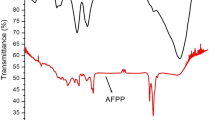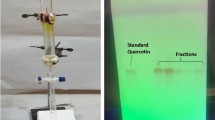Abstract
Organic wastes constitute a major share of Municipal Solid Wastes. The most beneficial approach to handling such wastes is to recover the bioactive constituents by biovalorization, making full use of them in the food, pharmaceutical as well as cosmetics industry. In this paper, fruit residual waste is collected from the waste of a residential and fruit-juice centre in Purba Medinipur district of West Bengal (India). Physico-chemical analysis of the powder generated from these wastes indicates a heterogeneous nature of powder particles having a diameter ranging from 10 to 55 μm. The moisture content of the powder was nearly 4%. Important minerals like C, K, Ca, N, O, Na, Mg, Zn, Si, P and K were detected in the powder. Four different extracts were prepared from the powder using solvents: ethanol, methanol, petroleum ether and butanol. Biochemical analysis of each extract showed high antioxidant properties. Each extraction was profiled using Gas Chromatography-Mass Spectroscopy analysis to screen the presence of functional bioactive molecules. A total of 33 molecules were identified, among which notable were N-Hexadecanoic acid; Vitamine-E; Squalene; Ergosta-7; Oleic acid; Hexadecane; 1,16-Dichloro etc. Methanol, Ethanol, Petroleum ether and Butanol extracts showed cytotoxic potential against Pseudomonas aeruginosa MZ269380 having MIC (mg/Ml) values of 19.5, 12.5, 24.5 and 8 respectively. Biocompatibility assay of each extract showed no significant damage to goat’s erythrocytes at MIC concentration. Biovalorisation of fruit peels produces useful phytochemicals that can be used in the biomedical, food processing and cosmetics industries.
Graphical Abstract








Similar content being viewed by others
Change history
12 May 2023
A Correction to this paper has been published: https://doi.org/10.1007/s12649-023-02104-9
References
Schieber, A., Stintzing, F.C., Carle, R.: By-products of plant food processing as a source of functional compounds-recent developments. Trends Food Sci. Technol. 12, 401–413 (2001)
Vilariño, M.A., Carol, F., Caitlin, Q.: Food loss and waste reduction as an integral part of a circular economy. Front. Environ. Sci. 5, 21 (2017)
Salehiyoun, A.R., Sharifi, M., Di Maria, F., et al.: Effect of substituting organic fraction of municipal solid waste with fruit and vegetable wastes on anaerobic digestion. J. Mater. Cycles Waste Manag. 21, 1321–1331 (2019)
Koulakiotis, N.S., Purhonen, P., Gikas, E., Hebert, H., Tsarbopoulos, A.: Crocus-derived compounds alter the aggregation pathway of Alzheimer’s Disease: associated beta amyloid protein. Sci. Rep. 10(1), 18150 (2020)
Zhang, Q.W., Lin, L.G., Ye, W.C.: Techniques for extraction and isolation of natural products: a comprehensive review. Chin. Med. 13, 20–45 (2018)
Abubakar, A.R., Haque, M.: Preparation of Medicinal plants: basic extraction and fractionation procedures for experimental Purposes. J. Pharm. Bioallied Sci. 12(1), 1–10 (2020)
Koffi, E., Sea, T., Dodehe, Y., Soro, S.: Effect of solvent type on extraction of polyphenols from twenty three ivorian plants. J. Anim. Plant. Sci. 5, 550–558 (2010)
Altemimi, A., Lakhssassi, N., Baharlouei, A., Watson, D.G., Lightfoot, D.A.: Phytochemicals: extraction, isolation, and identification of Bioactive Compounds from Plant extracts. Plants (Basel). 6(4), 42 (2017). doi: https://doi.org/10.3390/plants6040042
Paul, K., Kumpulainen, J., Järvinen, R., Rissanen, H., Heliövaara, M., Reunanen, A., Hakulinen, T.A., Aromaa.: Flavonoid intake and risk of chronic diseases. Am. J. Clin. Nutr. 76(3), 560–568 (2002)
David, V., Rodriguez-Mateos, A., Corona, G., Oruna-Concha, M.J., Spencer, J.P.: E,: polyphenols and human health: prevention of disease and mechanisms of action. Nutrients. 2(11), 1106–1131 (2010)
Panche, A.N., Diwan, A.D., Chandra, S.R.: Flavonoids: an overview. J. Nutr. Sci. 5, e47 (2016)
Lim, Y.Y., Lim, T.T., Tee, J.J.: Antioxidant properties of guava fruit: comparison with some local fruits. Sunway Acad. J. 3, 9–20 (2006)
Ghasemi, K., Ghasemi, Y., Ebrahimzadeh, M.A.: Antioxidant activity, phenol and flavonoid contents of 13 citrus species peels and tissues. Pak J. Pharm. Sci. 22, 277–281 (2009)
Bor, T., Sulaiman, O., Aljaloud, R., Gyawali, S.A.: Antimicrobials from Herbs, Spices, and Plants. Fruits, Vegetables, and Herbs 3, 551–578 (2016)
Chinnici, F., Bendini, A., Gaiani, A., Riponi, C.: Radical scavenging activities of peels and pulp from cv. Golden Delicious apples as related to their phenolic composition. J. Agric. Food Chem. 52, 4684–4689 (2004)
Berardini, N., Frezer, R., Conrad, J., Beifuss, U., Carle, R., Schieber, A.: Screening of mango (Mangiferaindica) cultivars for their contents of flavanol O- and xanthone C-glycoside, anthocyanidins and pectin. J. Agric. Food Chem. 53, 1563–1570 (2005)
Dutta, A., Singh, M.: Comparative analysis of aqueous extracts of Amaranth and Coriander in scavenging free radical activity and protection of DNA against oxidative damage. Chiang Mai J. Sci. 38(4), 560–571 (2011)
Sathya, B.V., Velpandian, Kumar, M.P.: Physicochemical characterization andinstrumental analysis of the polyherbal siddha contraceptive formulation maavilingathymathirai. World J. Pharm. Sci. 3(9), 789–799 (2014)
Redfern, J., Kinninmonth, M., Burdass, D., Verran, J.: Using soxhlet ethanol extraction to produce and test plant material (essential oils) for their antimicrobial properties. J. Micro Bio Ed. 15(1), 45–46 (2014)
Devmurari, V., Ghodasara, T.J., Jivani, N.P.: Antibacterial activity and Phytochemical Study of Extract of Triumfetta homboidea Jacq. Int. J. Pharm. Tech. Res. 2(2), 1182–1186 (2010)
Mallard, W.G., Linstrom, P.J.: (eds.) (eds.): NIST Standard Reference Database, National Institute of Standards and Technology. NIST Chemistry Web Book. (2008). https://webbook.nist.gov)
Das, M., Roy, S., Guha, C., Saha, A.K., Singh, M.: In vitro evaluation of antioxidant and antibacterial properties of supercritical CO2 extracted essential oil from clove bud (Syzygium aromaticum). J. Plant. Biochem. Biotechnol. 30, 387–391 (2021)
Goswami, S.R., Sahareen, T., Singh, M., Kumar, S.: Role of biogenic silver nanoparticles in disruption of cell–cell adhesion in Staphylococcus aureus and Escherichia coli biofilm. J. Ind. Eng. Chem. 26, 73–80 (2015)
Chockchaisawasdee, S., Stathopoulos, C.E.: Extraction, isolation and utilisation of bioactive compounds from fruit juice industry waste. In: Utilisation of Bioactive Compounds from Agricultural and Food Waste. CRC Press, Boca Raton (2017)
Morsy, K.M., Enas, M., Rasha, E.: Impact of pomegranate peel nanoparticles on quality attributes of meatballs during refrigerated storage. LWT 89, 489 (2018)
Dash, S., Nath, L.K., Bhise, S., Bhuyan, N.: Antioxidant and antimicrobial activities of Heracleum nepalense D Don root. Trop. J. Pharm. Res. 4, 341–347 (2005)
Ralte, L., Khiangte, L., Thangjam, N.M.: GC–MS and molecular docking analyses of phytochemicals from the underutilized plant, Parkia timoriana revealed candidate anti-cancerous and anti-inflammatory agents. Sci. Rep. 12, 3395 (2022). https://doi.org/10.1038/s41598-022-07320-2
Singh, A.S., Vellapandian, C.: Phytochemical Studies, antioxidant potential, and identification of bioactive compounds using GC-MS of the ethanolic extract of luffa cylindrica (L.) Fruit. Appl. Biochem. Biotechnol. 194(9), 4018–4032 (2022)
Ferdous, N., Rahman, M., Alamgir, A.N.: Investigation on phytochemical, cytotoxic and antimicrobial properties of ethanolic extracts of Centella asiatica (L.) Urban. J. Med. Plants. 5, 187–188 (2017)
Ezhilan, B.P., Neelamegam, R.: GC-MS analysis of phytocomponents in the ethanol extract of Polygonum chinense L. Pharmacognosy Res. 4(1), 11–14 (2012). https://doi.org/10.4103/0974-8490.91028
Ezhilan, B.P., Neelamegam, R.: GC-MS analysis of phytocomponents in the ethanol extract of Polygonum chinense L. Pharmacognosy Res. 4(1), 11–14 (2012)
Shiva, S., Mari, S., Amuthan, A., Shanmugam, R.: Repurposing Siddha mercurial drug for mild to moderate COVID-19 - case series and exploration of its chemical profile. J. Ayurveda Integr. Med. 13(2), 100469 (2022)
National Center for Biotechnology Information: : “PubChem Compound Summary for CID 3931, 9,12-Octadecadienoicacid. (2022). https://pubchem.ncbi.nlm.nih.gov/compound/9_12 Octadecadienoic-acid
National Center for Biotechnology Information: : PubChem Compound Summary for CID 12389, Tetradecane. (2022). https://pubchem.ncbi.nlm.nih.gov/compound/Tetradecane
National Center for Biotechnology: : Information PubChem Compound Summary for CID 23741, 1,2-Epoxyhexadecane. (2022). https://pubchem.ncbi.nlm.nih.gov/compound/1_2-Epoxyhexadecane
National Center for Biotechnology: : Information PubChem Compound Summary for CID 425400, Tocopherol succinate. (2022). https://pubchem.ncbi.nlm.nih.gov/compound/Tocopherol-succinate
Madureira, A.M., Ascenso, J.R., Valdeira, L., Duarte, A., Frade, J.P., Freitas, G., Ferreira, M.J.: Evaluation of the antiviral and antimicrobial activities of triterpenes isolated from Euphorbia segetalis. Nat. Prod. Res. 5, 375–80 (2003)
National Center for Biotechnology Information: : “PubChem Compound Summary for CID31404, Butylated hydroxytoluene (2022). https://pubchem.ncbi.nlm.nih.gov/compound/Butylated-hydroxytoluene
National Center for Biotechnology Information: : “PubChem Compound Summary for CID 5281, Stearic acid. (2022). https://pubchem.ncbi.nlm.nih.gov/compound/Stearic-acid,
National Center for Biotechnology Information: : “PubChem Compound Summary for CID 445639, Oleic acid, (2022). https://pubchem.ncbi.nlm.nih.gov/compound/Oleic-acid.
Gabriele, V., Gnoni, N., Francesco, J.H., Math, Geelen, S.: Luisa.: Oleic Acid as an Inhibitor of Fatty Acid and Cholesterol Synthesis, Olives and Olive Oil in Health and Disease Prevention. Academic Press. Chapter 152 - Pages 1365–1373 (2010)
Ruiz, M.A., José, L., Arias, Visitación, G.: Skin creams made with olive oil olives and olive oil in health and disease prevention. Academic Press, Cambridge (2010)
Liu, C.M., Kao, C.L., Wu, H.M., Li, W.J., Huang, C.T., Li, H.T., Chen, C.Y.: Antioxidant and anticancer aporphine alkaloids from the leaves of Nelumbo nucifera Gaertn. cv. Rosa-plena. Molecules 19(11), 17829–17838 (2014)
Agoramoorthy, M., Chandrasekaran, V., Venkatesalu, M.J.H.: Antibacterial and antifungal activities of fatty acid methyl esters of the blind-your-eye mangrove from India. Braz J. Microbiol. 38, 739–742 (2007)
Aparna, V., Dileep, K.V., Mandal, P.K., et al.: Anti-inflammatory property of n-hexadecanoic acid: structural evidence and kinetic assessment. Chem. Biol. Drug Des. 80(3), 434–439 (2012)
Zahara, K., Bibi, Y., Arshad, M., Kaukab, G., Al Ayoubi, S., Qayyum, A.: In-vitro examination and isolation of antidiarrheal compounds using five bacterial strains from invasive species Bidens bipinnata L. Saudi J. Biol. Sci. 29(1), 472–479 (2022)
Casillas-Vargas, G., Ocasio-Malavé, C., Medinam, S., Morales-Guzmán, C., Valle, D., Carballeira, R.G., Sanabria-Ríos, N.M.: Antibacterial fatty acids: an update of possible mechanisms of action and implications in the development of the next-generation of antibacterial agents. Prog. Lipid Res. 82, 101093 (2021)
Wright, H.T., Reynolds, K.A.: Antibacterial targets in fatty acid biosynthesis. Curr. Opin. Microbiol. 10(5), 447–453 (2007)
Heath, R.J., Rock, C.O.: Fatty acid biosynthesis as a target for novel antibacterials. Curr. Opin. Investig. Drugs 5(2), 146–153 (2004)
Naguib, M.M., Valvano, M.A.: Vitamin E increases antimicrobial sensitivity by inhibiting bacterial lipocalin antibiotic binding. mSphere 3(6), e00564-18 (2018). https://doi.org/10.1128/mSphere.00564-18
Yuan, W., Feng, Y., Wang, H., et al.: Hemocompatible surface of electrospun nanofibrous scaffolds by ATRP modification. Mater. Sci. Eng. C. 33, 3644–3651 (2013)
Bernini, J.C., Mustafa, M.M., Sutor, L.J., Buchanan, G.R.: Fatal hemolysis induced by ceftriaxone in a child with sickle cell anemia. J. Pediatr. 126, 813–825 (1995). https://doi.org/10.1016/s0022-3476(95)70417-5
Fazley, M., Elahi, G.G., Lu, W.: Hemocompatibility of surface modified silk fibroin materials; a review. Rev. Adv. Mater. Sci. 38, 148–159 (2014)
Stefania, L., Anna, M.A., Claudia, B., Marco, C., Alessandro, D., Gemma, L., Claudio, R., Gabriella, T., Luana, G., Ersilia, F., Paolo, F., Ilaria, C., Agnese, M.: Evaluation of in vitro cell and blood compatibility and in vivo analgesic activity of plant-derived dietary supplements. J. Integr. Med. 17, 213–220 (2019)
Acknowledgements
Authors are thankful for support from the department of Biotechnology and Food Technology, Haldia Instiitute of technology, Haldia.
Funding
The authors have no relevant financial or non-financial interests to disclose.
Author information
Authors and Affiliations
Contributions
MS and PKB: planned and designed this research article. Material preparation and data collection were done by RKT. Biochemical assays performed by RKT, SP and AB. Results analysis done by MS. The first draft of the manuscript was written by RK Thakur. All authors read and approved the final manuscript for submission.
Corresponding author
Ethics declarations
Conflict of interest
Authors do not have any conflicts of interest.
Ethical Approval
NA.
Consent to Participate
NA.
Consent to Publish
All authors agreed to publish this paper in this journal.
Additional information
Publisher’s Note
Springer Nature remains neutral with regard to jurisdictional claims in published maps and institutional affiliations.
The original online version of this article was revised: In the original publication of the article, the affiliation of coauthor “Prasanta Kumar Biswas” was published incorrectly. The same has been corrected and provided in this correction.
Rights and permissions
Springer Nature or its licensor (e.g. a society or other partner) holds exclusive rights to this article under a publishing agreement with the author(s) or other rightsholder(s); author self-archiving of the accepted manuscript version of this article is solely governed by the terms of such publishing agreement and applicable law.
About this article
Cite this article
Thakur, R.K., Singh, M., Patra, S. et al. Phytochemicals Identification Using GC-MS in Four Extracts of Fruit Peels and Enactment of Extracts Against Pseudomonas Aeruginosa MZ269380. Waste Biomass Valor 14, 3043–3057 (2023). https://doi.org/10.1007/s12649-023-02062-2
Received:
Accepted:
Published:
Issue Date:
DOI: https://doi.org/10.1007/s12649-023-02062-2




